Literature Review: Collaborative Working and BIM Design Management
VerifiedAdded on 2023/01/11
|11
|3909
|27
Report
AI Summary
This report provides a comprehensive analysis of collaborative working and the design management process within Building Information Modeling (BIM) enabled projects. The introduction highlights BIM's significance in the Architecture, Engineering, and Construction (AEC) industry, emphasizing its role in integrating stakeholders and improving project outcomes. The main body delves into the importance of effective design management processes and collaborative working strategies. It explores how BIM facilitates communication, reduces waste, and enhances managerial efficiency. The report examines various strategies, including the use of user-friendly data interfaces and production management systems, alongside the challenges such as the high costs of implementation. The role of BIM in the AEC industry is also discussed, including its impact on information management and overall building lifecycle, from design to material reuse. The report underscores the benefits of collaborative working, such as reducing time delays and communication gaps, ultimately improving project outcomes in terms of time, cost, and quality. The report emphasizes the use of 3D models for effective communication and concludes by highlighting the key factors for success in BIM-enabled projects. This report is available on Desklib, where students can find past papers and solved assignments for their studies.
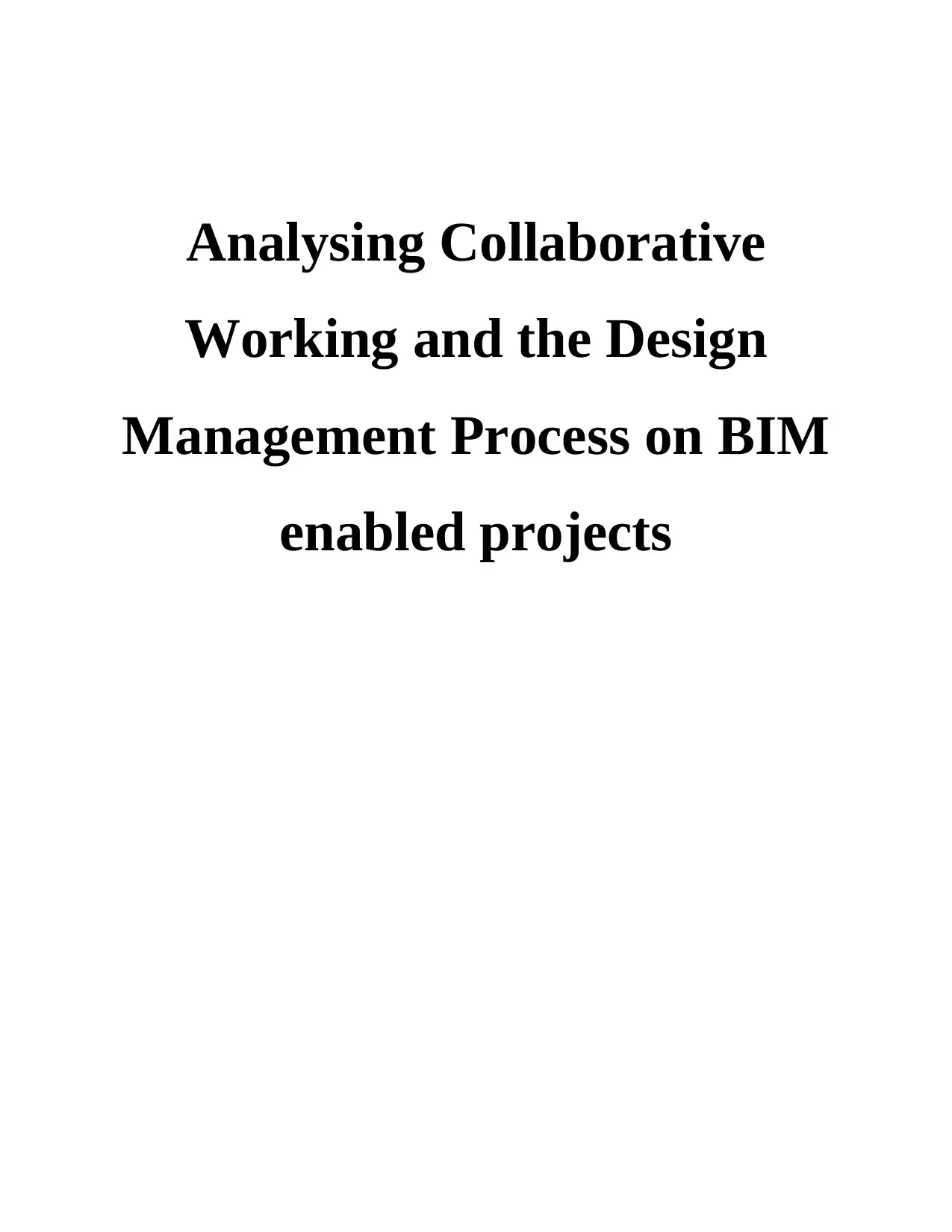
Analysing Collaborative
Working and the Design
Management Process on BIM
enabled projects
Working and the Design
Management Process on BIM
enabled projects
Paraphrase This Document
Need a fresh take? Get an instant paraphrase of this document with our AI Paraphraser
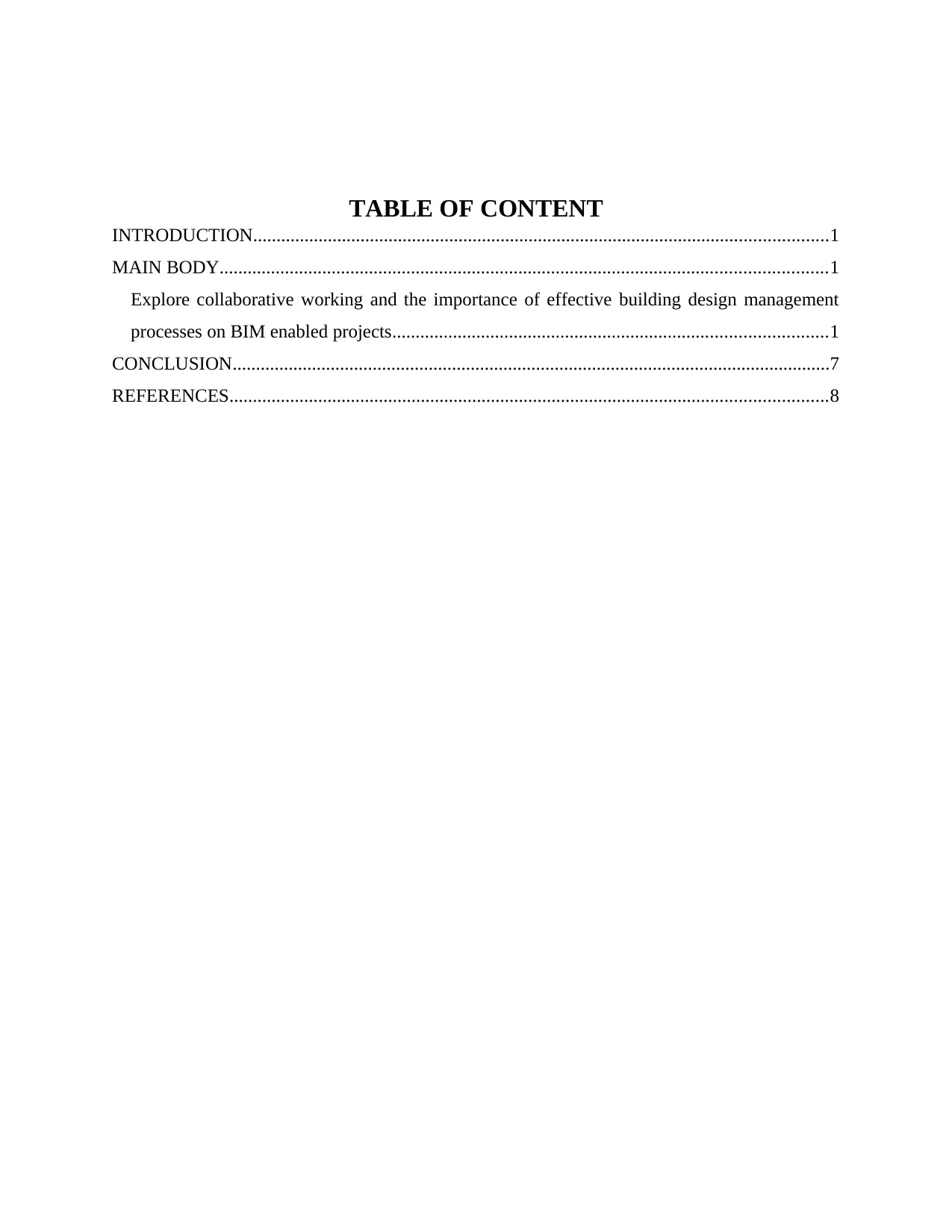
TABLE OF CONTENT
INTRODUCTION...........................................................................................................................1
MAIN BODY..................................................................................................................................1
Explore collaborative working and the importance of effective building design management
processes on BIM enabled projects.............................................................................................1
CONCLUSION................................................................................................................................7
REFERENCES................................................................................................................................8
INTRODUCTION...........................................................................................................................1
MAIN BODY..................................................................................................................................1
Explore collaborative working and the importance of effective building design management
processes on BIM enabled projects.............................................................................................1
CONCLUSION................................................................................................................................7
REFERENCES................................................................................................................................8
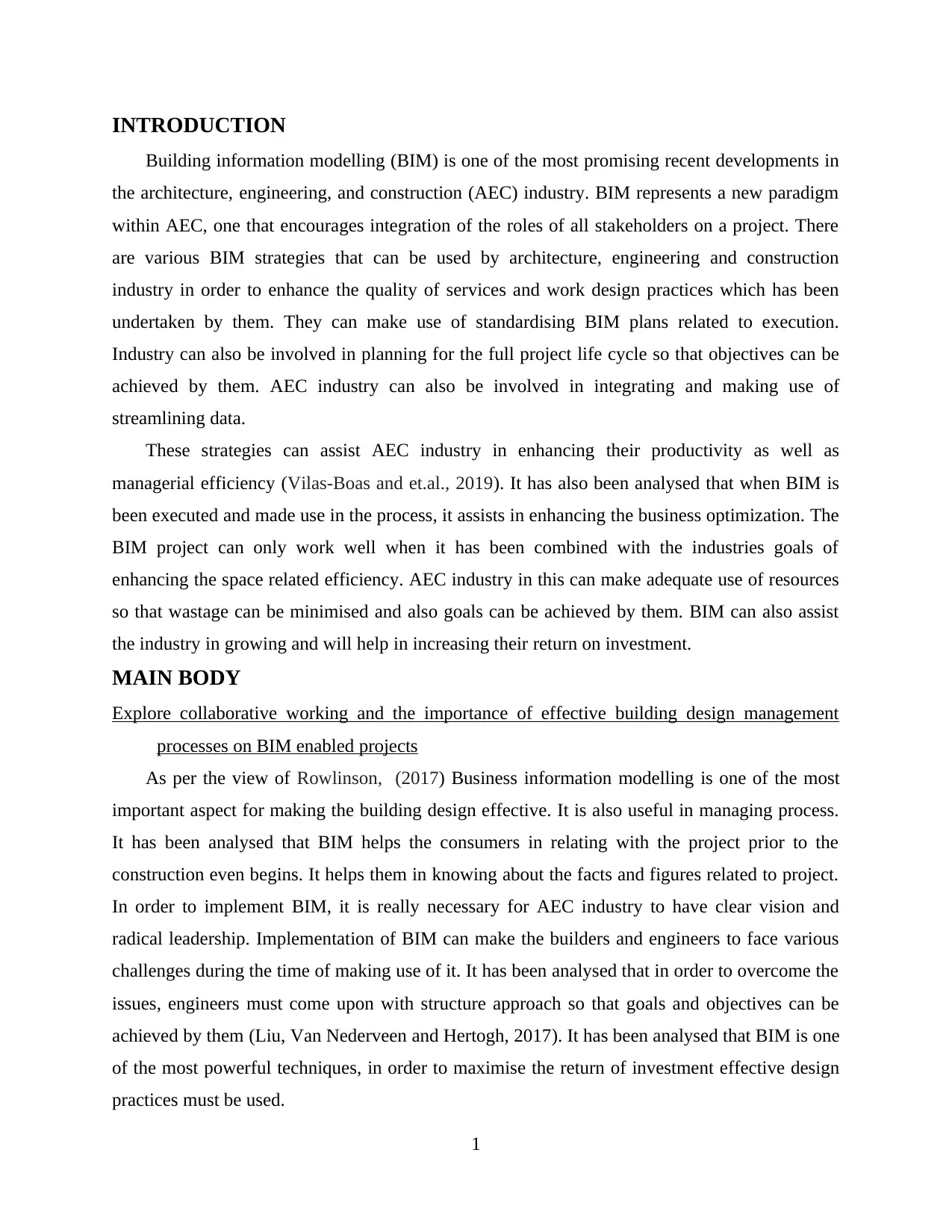
INTRODUCTION
Building information modelling (BIM) is one of the most promising recent developments in
the architecture, engineering, and construction (AEC) industry. BIM represents a new paradigm
within AEC, one that encourages integration of the roles of all stakeholders on a project. There
are various BIM strategies that can be used by architecture, engineering and construction
industry in order to enhance the quality of services and work design practices which has been
undertaken by them. They can make use of standardising BIM plans related to execution.
Industry can also be involved in planning for the full project life cycle so that objectives can be
achieved by them. AEC industry can also be involved in integrating and making use of
streamlining data.
These strategies can assist AEC industry in enhancing their productivity as well as
managerial efficiency (Vilas-Boas and et.al., 2019). It has also been analysed that when BIM is
been executed and made use in the process, it assists in enhancing the business optimization. The
BIM project can only work well when it has been combined with the industries goals of
enhancing the space related efficiency. AEC industry in this can make adequate use of resources
so that wastage can be minimised and also goals can be achieved by them. BIM can also assist
the industry in growing and will help in increasing their return on investment.
MAIN BODY
Explore collaborative working and the importance of effective building design management
processes on BIM enabled projects
As per the view of Rowlinson, (2017) Business information modelling is one of the most
important aspect for making the building design effective. It is also useful in managing process.
It has been analysed that BIM helps the consumers in relating with the project prior to the
construction even begins. It helps them in knowing about the facts and figures related to project.
In order to implement BIM, it is really necessary for AEC industry to have clear vision and
radical leadership. Implementation of BIM can make the builders and engineers to face various
challenges during the time of making use of it. It has been analysed that in order to overcome the
issues, engineers must come upon with structure approach so that goals and objectives can be
achieved by them (Liu, Van Nederveen and Hertogh, 2017). It has been analysed that BIM is one
of the most powerful techniques, in order to maximise the return of investment effective design
practices must be used.
1
Building information modelling (BIM) is one of the most promising recent developments in
the architecture, engineering, and construction (AEC) industry. BIM represents a new paradigm
within AEC, one that encourages integration of the roles of all stakeholders on a project. There
are various BIM strategies that can be used by architecture, engineering and construction
industry in order to enhance the quality of services and work design practices which has been
undertaken by them. They can make use of standardising BIM plans related to execution.
Industry can also be involved in planning for the full project life cycle so that objectives can be
achieved by them. AEC industry can also be involved in integrating and making use of
streamlining data.
These strategies can assist AEC industry in enhancing their productivity as well as
managerial efficiency (Vilas-Boas and et.al., 2019). It has also been analysed that when BIM is
been executed and made use in the process, it assists in enhancing the business optimization. The
BIM project can only work well when it has been combined with the industries goals of
enhancing the space related efficiency. AEC industry in this can make adequate use of resources
so that wastage can be minimised and also goals can be achieved by them. BIM can also assist
the industry in growing and will help in increasing their return on investment.
MAIN BODY
Explore collaborative working and the importance of effective building design management
processes on BIM enabled projects
As per the view of Rowlinson, (2017) Business information modelling is one of the most
important aspect for making the building design effective. It is also useful in managing process.
It has been analysed that BIM helps the consumers in relating with the project prior to the
construction even begins. It helps them in knowing about the facts and figures related to project.
In order to implement BIM, it is really necessary for AEC industry to have clear vision and
radical leadership. Implementation of BIM can make the builders and engineers to face various
challenges during the time of making use of it. It has been analysed that in order to overcome the
issues, engineers must come upon with structure approach so that goals and objectives can be
achieved by them (Liu, Van Nederveen and Hertogh, 2017). It has been analysed that BIM is one
of the most powerful techniques, in order to maximise the return of investment effective design
practices must be used.
1
⊘ This is a preview!⊘
Do you want full access?
Subscribe today to unlock all pages.

Trusted by 1+ million students worldwide
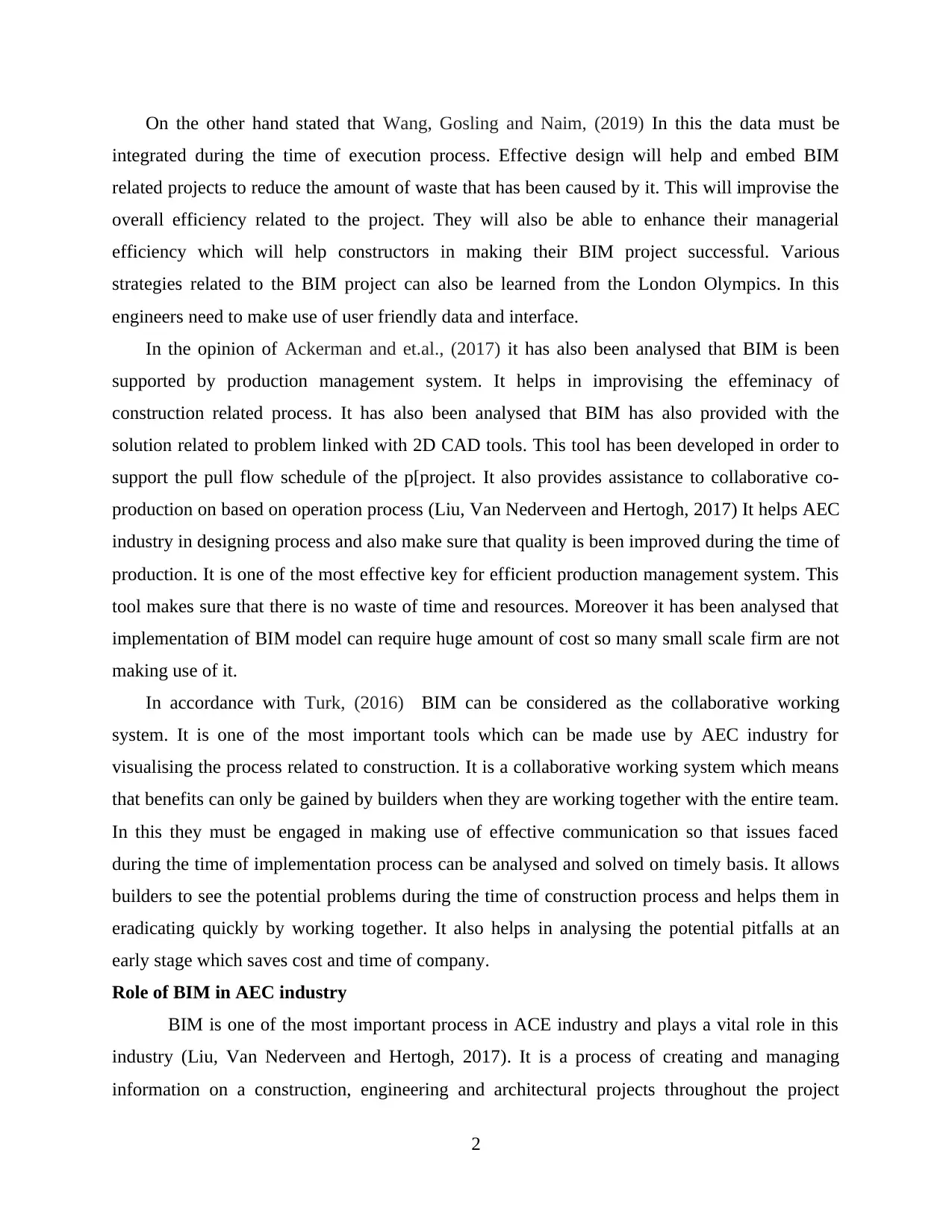
On the other hand stated that Wang, Gosling and Naim, (2019) In this the data must be
integrated during the time of execution process. Effective design will help and embed BIM
related projects to reduce the amount of waste that has been caused by it. This will improvise the
overall efficiency related to the project. They will also be able to enhance their managerial
efficiency which will help constructors in making their BIM project successful. Various
strategies related to the BIM project can also be learned from the London Olympics. In this
engineers need to make use of user friendly data and interface.
In the opinion of Ackerman and et.al., (2017) it has also been analysed that BIM is been
supported by production management system. It helps in improvising the effeminacy of
construction related process. It has also been analysed that BIM has also provided with the
solution related to problem linked with 2D CAD tools. This tool has been developed in order to
support the pull flow schedule of the p[project. It also provides assistance to collaborative co-
production on based on operation process (Liu, Van Nederveen and Hertogh, 2017) It helps AEC
industry in designing process and also make sure that quality is been improved during the time of
production. It is one of the most effective key for efficient production management system. This
tool makes sure that there is no waste of time and resources. Moreover it has been analysed that
implementation of BIM model can require huge amount of cost so many small scale firm are not
making use of it.
In accordance with Turk, (2016) BIM can be considered as the collaborative working
system. It is one of the most important tools which can be made use by AEC industry for
visualising the process related to construction. It is a collaborative working system which means
that benefits can only be gained by builders when they are working together with the entire team.
In this they must be engaged in making use of effective communication so that issues faced
during the time of implementation process can be analysed and solved on timely basis. It allows
builders to see the potential problems during the time of construction process and helps them in
eradicating quickly by working together. It also helps in analysing the potential pitfalls at an
early stage which saves cost and time of company.
Role of BIM in AEC industry
BIM is one of the most important process in ACE industry and plays a vital role in this
industry (Liu, Van Nederveen and Hertogh, 2017). It is a process of creating and managing
information on a construction, engineering and architectural projects throughout the project
2
integrated during the time of execution process. Effective design will help and embed BIM
related projects to reduce the amount of waste that has been caused by it. This will improvise the
overall efficiency related to the project. They will also be able to enhance their managerial
efficiency which will help constructors in making their BIM project successful. Various
strategies related to the BIM project can also be learned from the London Olympics. In this
engineers need to make use of user friendly data and interface.
In the opinion of Ackerman and et.al., (2017) it has also been analysed that BIM is been
supported by production management system. It helps in improvising the effeminacy of
construction related process. It has also been analysed that BIM has also provided with the
solution related to problem linked with 2D CAD tools. This tool has been developed in order to
support the pull flow schedule of the p[project. It also provides assistance to collaborative co-
production on based on operation process (Liu, Van Nederveen and Hertogh, 2017) It helps AEC
industry in designing process and also make sure that quality is been improved during the time of
production. It is one of the most effective key for efficient production management system. This
tool makes sure that there is no waste of time and resources. Moreover it has been analysed that
implementation of BIM model can require huge amount of cost so many small scale firm are not
making use of it.
In accordance with Turk, (2016) BIM can be considered as the collaborative working
system. It is one of the most important tools which can be made use by AEC industry for
visualising the process related to construction. It is a collaborative working system which means
that benefits can only be gained by builders when they are working together with the entire team.
In this they must be engaged in making use of effective communication so that issues faced
during the time of implementation process can be analysed and solved on timely basis. It allows
builders to see the potential problems during the time of construction process and helps them in
eradicating quickly by working together. It also helps in analysing the potential pitfalls at an
early stage which saves cost and time of company.
Role of BIM in AEC industry
BIM is one of the most important process in ACE industry and plays a vital role in this
industry (Liu, Van Nederveen and Hertogh, 2017). It is a process of creating and managing
information on a construction, engineering and architectural projects throughout the project
2
Paraphrase This Document
Need a fresh take? Get an instant paraphrase of this document with our AI Paraphraser
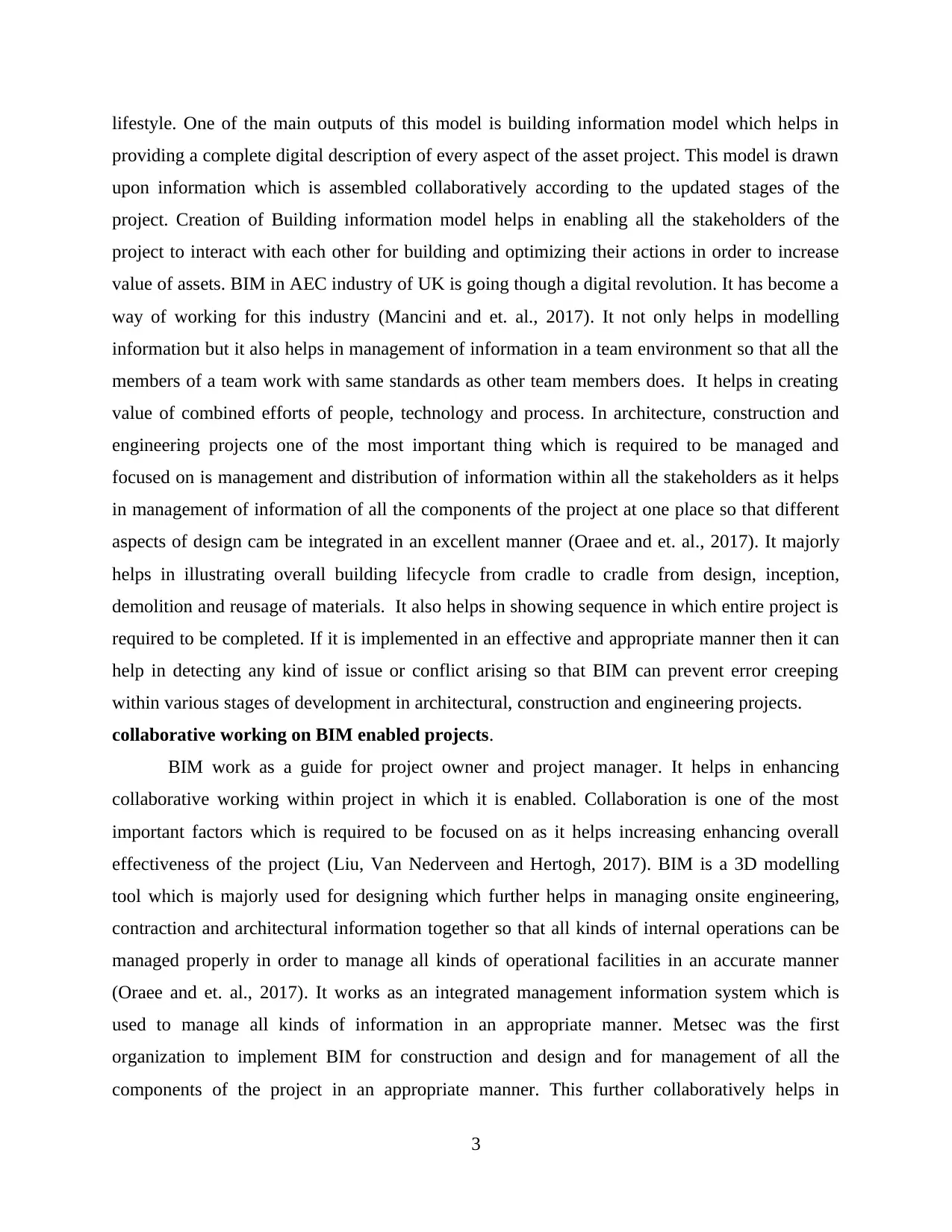
lifestyle. One of the main outputs of this model is building information model which helps in
providing a complete digital description of every aspect of the asset project. This model is drawn
upon information which is assembled collaboratively according to the updated stages of the
project. Creation of Building information model helps in enabling all the stakeholders of the
project to interact with each other for building and optimizing their actions in order to increase
value of assets. BIM in AEC industry of UK is going though a digital revolution. It has become a
way of working for this industry (Mancini and et. al., 2017). It not only helps in modelling
information but it also helps in management of information in a team environment so that all the
members of a team work with same standards as other team members does. It helps in creating
value of combined efforts of people, technology and process. In architecture, construction and
engineering projects one of the most important thing which is required to be managed and
focused on is management and distribution of information within all the stakeholders as it helps
in management of information of all the components of the project at one place so that different
aspects of design cam be integrated in an excellent manner (Oraee and et. al., 2017). It majorly
helps in illustrating overall building lifecycle from cradle to cradle from design, inception,
demolition and reusage of materials. It also helps in showing sequence in which entire project is
required to be completed. If it is implemented in an effective and appropriate manner then it can
help in detecting any kind of issue or conflict arising so that BIM can prevent error creeping
within various stages of development in architectural, construction and engineering projects.
collaborative working on BIM enabled projects.
BIM work as a guide for project owner and project manager. It helps in enhancing
collaborative working within project in which it is enabled. Collaboration is one of the most
important factors which is required to be focused on as it helps increasing enhancing overall
effectiveness of the project (Liu, Van Nederveen and Hertogh, 2017). BIM is a 3D modelling
tool which is majorly used for designing which further helps in managing onsite engineering,
contraction and architectural information together so that all kinds of internal operations can be
managed properly in order to manage all kinds of operational facilities in an accurate manner
(Oraee and et. al., 2017). It works as an integrated management information system which is
used to manage all kinds of information in an appropriate manner. Metsec was the first
organization to implement BIM for construction and design and for management of all the
components of the project in an appropriate manner. This further collaboratively helps in
3
providing a complete digital description of every aspect of the asset project. This model is drawn
upon information which is assembled collaboratively according to the updated stages of the
project. Creation of Building information model helps in enabling all the stakeholders of the
project to interact with each other for building and optimizing their actions in order to increase
value of assets. BIM in AEC industry of UK is going though a digital revolution. It has become a
way of working for this industry (Mancini and et. al., 2017). It not only helps in modelling
information but it also helps in management of information in a team environment so that all the
members of a team work with same standards as other team members does. It helps in creating
value of combined efforts of people, technology and process. In architecture, construction and
engineering projects one of the most important thing which is required to be managed and
focused on is management and distribution of information within all the stakeholders as it helps
in management of information of all the components of the project at one place so that different
aspects of design cam be integrated in an excellent manner (Oraee and et. al., 2017). It majorly
helps in illustrating overall building lifecycle from cradle to cradle from design, inception,
demolition and reusage of materials. It also helps in showing sequence in which entire project is
required to be completed. If it is implemented in an effective and appropriate manner then it can
help in detecting any kind of issue or conflict arising so that BIM can prevent error creeping
within various stages of development in architectural, construction and engineering projects.
collaborative working on BIM enabled projects.
BIM work as a guide for project owner and project manager. It helps in enhancing
collaborative working within project in which it is enabled. Collaboration is one of the most
important factors which is required to be focused on as it helps increasing enhancing overall
effectiveness of the project (Liu, Van Nederveen and Hertogh, 2017). BIM is a 3D modelling
tool which is majorly used for designing which further helps in managing onsite engineering,
contraction and architectural information together so that all kinds of internal operations can be
managed properly in order to manage all kinds of operational facilities in an accurate manner
(Oraee and et. al., 2017). It works as an integrated management information system which is
used to manage all kinds of information in an appropriate manner. Metsec was the first
organization to implement BIM for construction and design and for management of all the
components of the project in an appropriate manner. This further collaboratively helps in
3
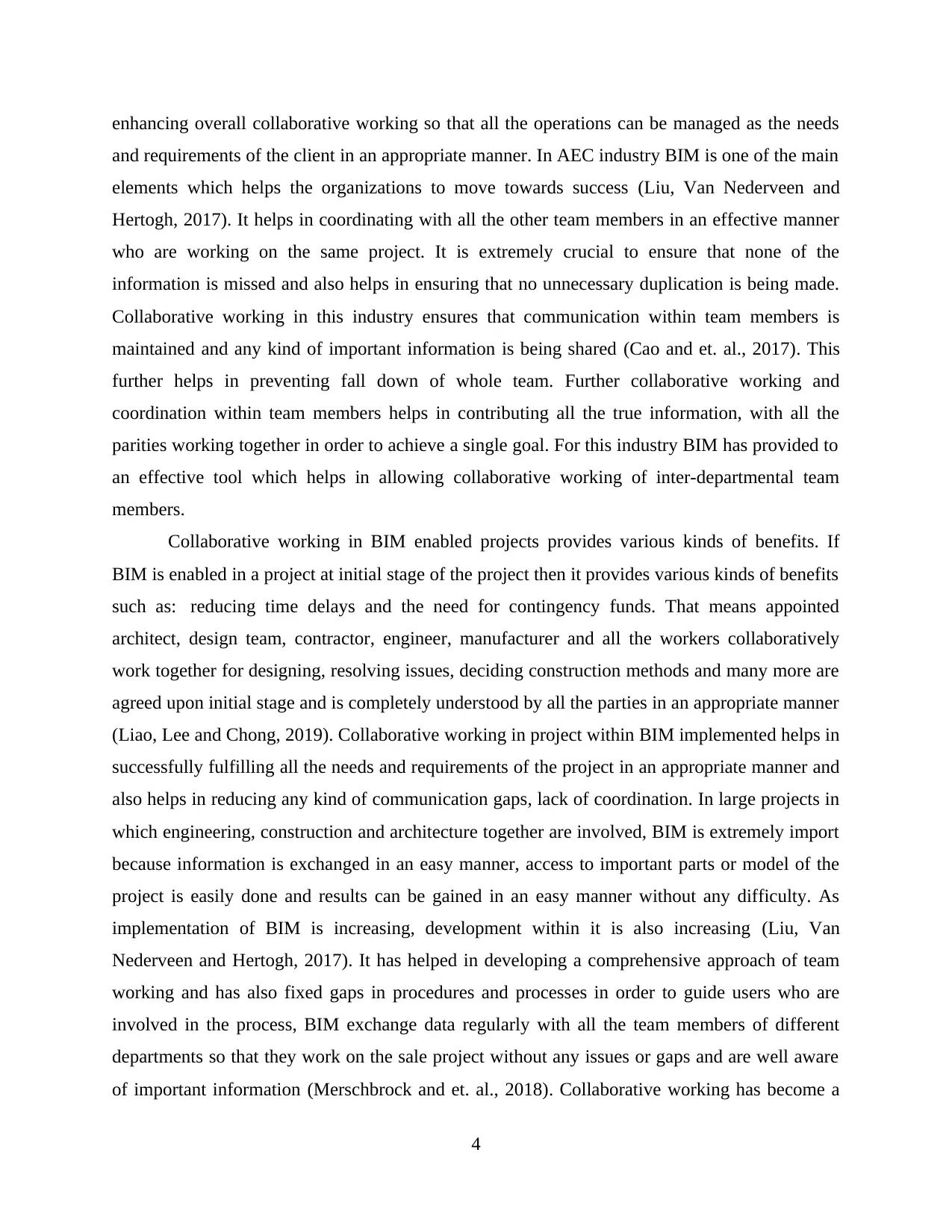
enhancing overall collaborative working so that all the operations can be managed as the needs
and requirements of the client in an appropriate manner. In AEC industry BIM is one of the main
elements which helps the organizations to move towards success (Liu, Van Nederveen and
Hertogh, 2017). It helps in coordinating with all the other team members in an effective manner
who are working on the same project. It is extremely crucial to ensure that none of the
information is missed and also helps in ensuring that no unnecessary duplication is being made.
Collaborative working in this industry ensures that communication within team members is
maintained and any kind of important information is being shared (Cao and et. al., 2017). This
further helps in preventing fall down of whole team. Further collaborative working and
coordination within team members helps in contributing all the true information, with all the
parities working together in order to achieve a single goal. For this industry BIM has provided to
an effective tool which helps in allowing collaborative working of inter-departmental team
members.
Collaborative working in BIM enabled projects provides various kinds of benefits. If
BIM is enabled in a project at initial stage of the project then it provides various kinds of benefits
such as: reducing time delays and the need for contingency funds. That means appointed
architect, design team, contractor, engineer, manufacturer and all the workers collaboratively
work together for designing, resolving issues, deciding construction methods and many more are
agreed upon initial stage and is completely understood by all the parties in an appropriate manner
(Liao, Lee and Chong, 2019). Collaborative working in project within BIM implemented helps in
successfully fulfilling all the needs and requirements of the project in an appropriate manner and
also helps in reducing any kind of communication gaps, lack of coordination. In large projects in
which engineering, construction and architecture together are involved, BIM is extremely import
because information is exchanged in an easy manner, access to important parts or model of the
project is easily done and results can be gained in an easy manner without any difficulty. As
implementation of BIM is increasing, development within it is also increasing (Liu, Van
Nederveen and Hertogh, 2017). It has helped in developing a comprehensive approach of team
working and has also fixed gaps in procedures and processes in order to guide users who are
involved in the process, BIM exchange data regularly with all the team members of different
departments so that they work on the sale project without any issues or gaps and are well aware
of important information (Merschbrock and et. al., 2018). Collaborative working has become a
4
and requirements of the client in an appropriate manner. In AEC industry BIM is one of the main
elements which helps the organizations to move towards success (Liu, Van Nederveen and
Hertogh, 2017). It helps in coordinating with all the other team members in an effective manner
who are working on the same project. It is extremely crucial to ensure that none of the
information is missed and also helps in ensuring that no unnecessary duplication is being made.
Collaborative working in this industry ensures that communication within team members is
maintained and any kind of important information is being shared (Cao and et. al., 2017). This
further helps in preventing fall down of whole team. Further collaborative working and
coordination within team members helps in contributing all the true information, with all the
parities working together in order to achieve a single goal. For this industry BIM has provided to
an effective tool which helps in allowing collaborative working of inter-departmental team
members.
Collaborative working in BIM enabled projects provides various kinds of benefits. If
BIM is enabled in a project at initial stage of the project then it provides various kinds of benefits
such as: reducing time delays and the need for contingency funds. That means appointed
architect, design team, contractor, engineer, manufacturer and all the workers collaboratively
work together for designing, resolving issues, deciding construction methods and many more are
agreed upon initial stage and is completely understood by all the parties in an appropriate manner
(Liao, Lee and Chong, 2019). Collaborative working in project within BIM implemented helps in
successfully fulfilling all the needs and requirements of the project in an appropriate manner and
also helps in reducing any kind of communication gaps, lack of coordination. In large projects in
which engineering, construction and architecture together are involved, BIM is extremely import
because information is exchanged in an easy manner, access to important parts or model of the
project is easily done and results can be gained in an easy manner without any difficulty. As
implementation of BIM is increasing, development within it is also increasing (Liu, Van
Nederveen and Hertogh, 2017). It has helped in developing a comprehensive approach of team
working and has also fixed gaps in procedures and processes in order to guide users who are
involved in the process, BIM exchange data regularly with all the team members of different
departments so that they work on the sale project without any issues or gaps and are well aware
of important information (Merschbrock and et. al., 2018). Collaborative working has become a
4
⊘ This is a preview!⊘
Do you want full access?
Subscribe today to unlock all pages.

Trusted by 1+ million students worldwide
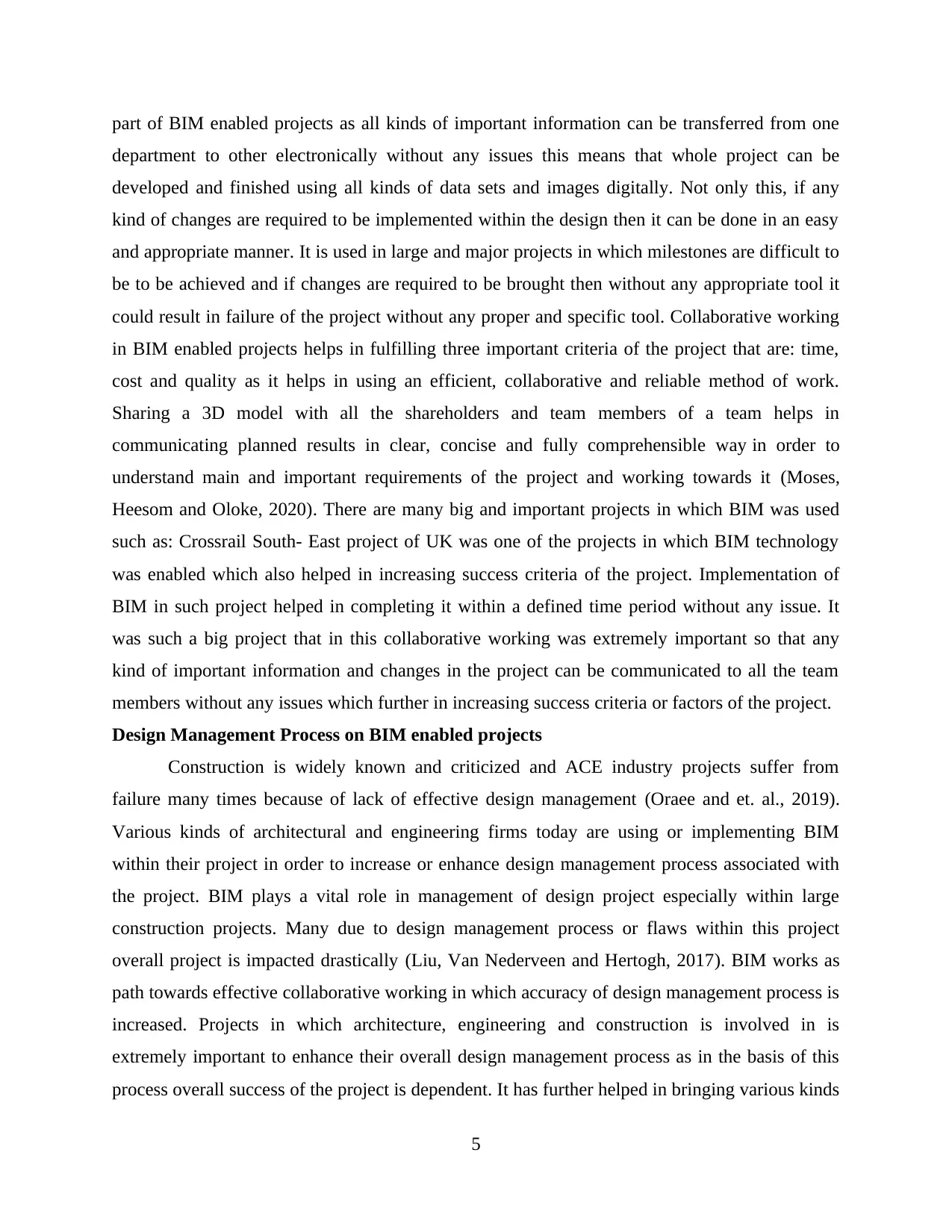
part of BIM enabled projects as all kinds of important information can be transferred from one
department to other electronically without any issues this means that whole project can be
developed and finished using all kinds of data sets and images digitally. Not only this, if any
kind of changes are required to be implemented within the design then it can be done in an easy
and appropriate manner. It is used in large and major projects in which milestones are difficult to
be to be achieved and if changes are required to be brought then without any appropriate tool it
could result in failure of the project without any proper and specific tool. Collaborative working
in BIM enabled projects helps in fulfilling three important criteria of the project that are: time,
cost and quality as it helps in using an efficient, collaborative and reliable method of work.
Sharing a 3D model with all the shareholders and team members of a team helps in
communicating planned results in clear, concise and fully comprehensible way in order to
understand main and important requirements of the project and working towards it (Moses,
Heesom and Oloke, 2020). There are many big and important projects in which BIM was used
such as: Crossrail South- East project of UK was one of the projects in which BIM technology
was enabled which also helped in increasing success criteria of the project. Implementation of
BIM in such project helped in completing it within a defined time period without any issue. It
was such a big project that in this collaborative working was extremely important so that any
kind of important information and changes in the project can be communicated to all the team
members without any issues which further in increasing success criteria or factors of the project.
Design Management Process on BIM enabled projects
Construction is widely known and criticized and ACE industry projects suffer from
failure many times because of lack of effective design management (Oraee and et. al., 2019).
Various kinds of architectural and engineering firms today are using or implementing BIM
within their project in order to increase or enhance design management process associated with
the project. BIM plays a vital role in management of design project especially within large
construction projects. Many due to design management process or flaws within this project
overall project is impacted drastically (Liu, Van Nederveen and Hertogh, 2017). BIM works as
path towards effective collaborative working in which accuracy of design management process is
increased. Projects in which architecture, engineering and construction is involved in is
extremely important to enhance their overall design management process as in the basis of this
process overall success of the project is dependent. It has further helped in bringing various kinds
5
department to other electronically without any issues this means that whole project can be
developed and finished using all kinds of data sets and images digitally. Not only this, if any
kind of changes are required to be implemented within the design then it can be done in an easy
and appropriate manner. It is used in large and major projects in which milestones are difficult to
be to be achieved and if changes are required to be brought then without any appropriate tool it
could result in failure of the project without any proper and specific tool. Collaborative working
in BIM enabled projects helps in fulfilling three important criteria of the project that are: time,
cost and quality as it helps in using an efficient, collaborative and reliable method of work.
Sharing a 3D model with all the shareholders and team members of a team helps in
communicating planned results in clear, concise and fully comprehensible way in order to
understand main and important requirements of the project and working towards it (Moses,
Heesom and Oloke, 2020). There are many big and important projects in which BIM was used
such as: Crossrail South- East project of UK was one of the projects in which BIM technology
was enabled which also helped in increasing success criteria of the project. Implementation of
BIM in such project helped in completing it within a defined time period without any issue. It
was such a big project that in this collaborative working was extremely important so that any
kind of important information and changes in the project can be communicated to all the team
members without any issues which further in increasing success criteria or factors of the project.
Design Management Process on BIM enabled projects
Construction is widely known and criticized and ACE industry projects suffer from
failure many times because of lack of effective design management (Oraee and et. al., 2019).
Various kinds of architectural and engineering firms today are using or implementing BIM
within their project in order to increase or enhance design management process associated with
the project. BIM plays a vital role in management of design project especially within large
construction projects. Many due to design management process or flaws within this project
overall project is impacted drastically (Liu, Van Nederveen and Hertogh, 2017). BIM works as
path towards effective collaborative working in which accuracy of design management process is
increased. Projects in which architecture, engineering and construction is involved in is
extremely important to enhance their overall design management process as in the basis of this
process overall success of the project is dependent. It has further helped in bringing various kinds
5
Paraphrase This Document
Need a fresh take? Get an instant paraphrase of this document with our AI Paraphraser
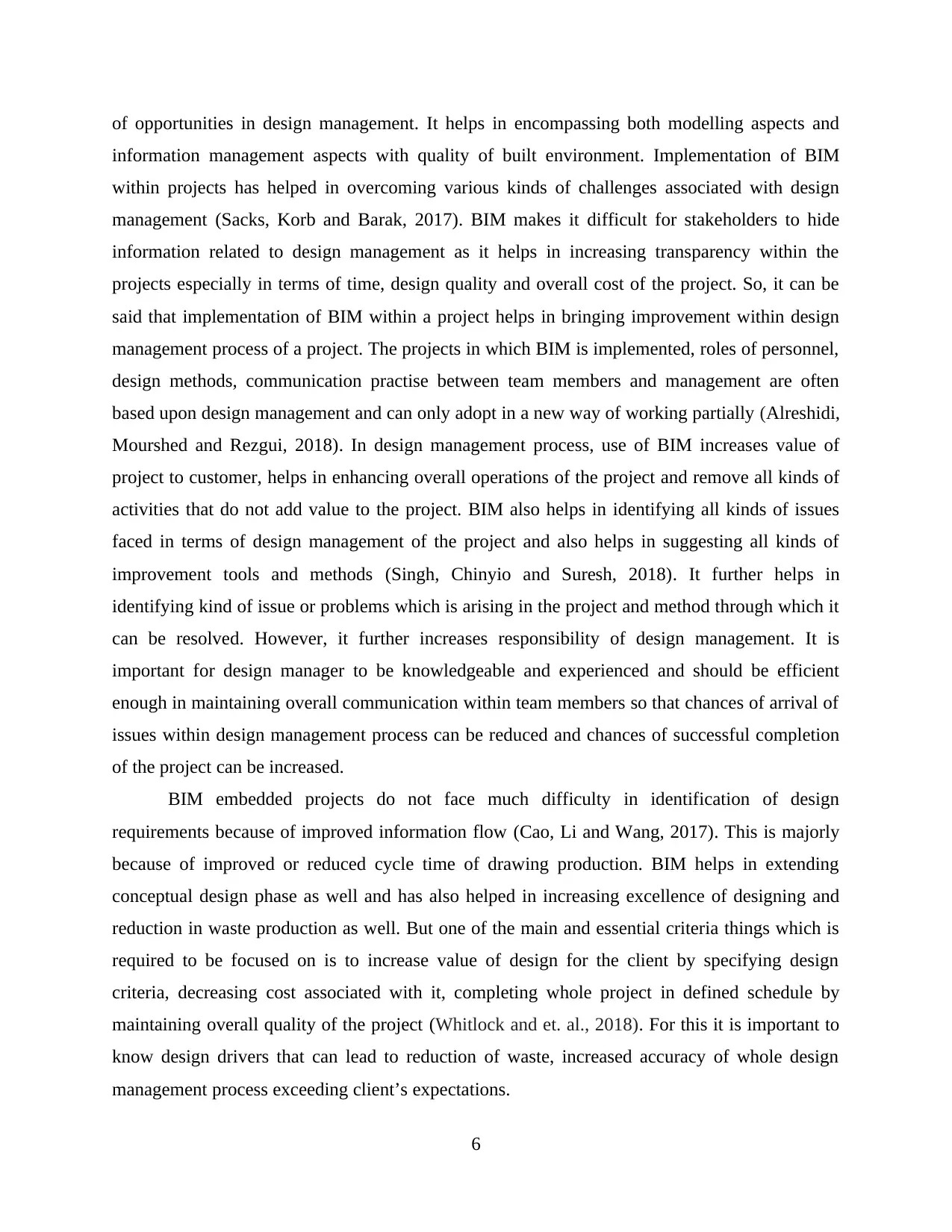
of opportunities in design management. It helps in encompassing both modelling aspects and
information management aspects with quality of built environment. Implementation of BIM
within projects has helped in overcoming various kinds of challenges associated with design
management (Sacks, Korb and Barak, 2017). BIM makes it difficult for stakeholders to hide
information related to design management as it helps in increasing transparency within the
projects especially in terms of time, design quality and overall cost of the project. So, it can be
said that implementation of BIM within a project helps in bringing improvement within design
management process of a project. The projects in which BIM is implemented, roles of personnel,
design methods, communication practise between team members and management are often
based upon design management and can only adopt in a new way of working partially (Alreshidi,
Mourshed and Rezgui, 2018). In design management process, use of BIM increases value of
project to customer, helps in enhancing overall operations of the project and remove all kinds of
activities that do not add value to the project. BIM also helps in identifying all kinds of issues
faced in terms of design management of the project and also helps in suggesting all kinds of
improvement tools and methods (Singh, Chinyio and Suresh, 2018). It further helps in
identifying kind of issue or problems which is arising in the project and method through which it
can be resolved. However, it further increases responsibility of design management. It is
important for design manager to be knowledgeable and experienced and should be efficient
enough in maintaining overall communication within team members so that chances of arrival of
issues within design management process can be reduced and chances of successful completion
of the project can be increased.
BIM embedded projects do not face much difficulty in identification of design
requirements because of improved information flow (Cao, Li and Wang, 2017). This is majorly
because of improved or reduced cycle time of drawing production. BIM helps in extending
conceptual design phase as well and has also helped in increasing excellence of designing and
reduction in waste production as well. But one of the main and essential criteria things which is
required to be focused on is to increase value of design for the client by specifying design
criteria, decreasing cost associated with it, completing whole project in defined schedule by
maintaining overall quality of the project (Whitlock and et. al., 2018). For this it is important to
know design drivers that can lead to reduction of waste, increased accuracy of whole design
management process exceeding client’s expectations.
6
information management aspects with quality of built environment. Implementation of BIM
within projects has helped in overcoming various kinds of challenges associated with design
management (Sacks, Korb and Barak, 2017). BIM makes it difficult for stakeholders to hide
information related to design management as it helps in increasing transparency within the
projects especially in terms of time, design quality and overall cost of the project. So, it can be
said that implementation of BIM within a project helps in bringing improvement within design
management process of a project. The projects in which BIM is implemented, roles of personnel,
design methods, communication practise between team members and management are often
based upon design management and can only adopt in a new way of working partially (Alreshidi,
Mourshed and Rezgui, 2018). In design management process, use of BIM increases value of
project to customer, helps in enhancing overall operations of the project and remove all kinds of
activities that do not add value to the project. BIM also helps in identifying all kinds of issues
faced in terms of design management of the project and also helps in suggesting all kinds of
improvement tools and methods (Singh, Chinyio and Suresh, 2018). It further helps in
identifying kind of issue or problems which is arising in the project and method through which it
can be resolved. However, it further increases responsibility of design management. It is
important for design manager to be knowledgeable and experienced and should be efficient
enough in maintaining overall communication within team members so that chances of arrival of
issues within design management process can be reduced and chances of successful completion
of the project can be increased.
BIM embedded projects do not face much difficulty in identification of design
requirements because of improved information flow (Cao, Li and Wang, 2017). This is majorly
because of improved or reduced cycle time of drawing production. BIM helps in extending
conceptual design phase as well and has also helped in increasing excellence of designing and
reduction in waste production as well. But one of the main and essential criteria things which is
required to be focused on is to increase value of design for the client by specifying design
criteria, decreasing cost associated with it, completing whole project in defined schedule by
maintaining overall quality of the project (Whitlock and et. al., 2018). For this it is important to
know design drivers that can lead to reduction of waste, increased accuracy of whole design
management process exceeding client’s expectations.
6
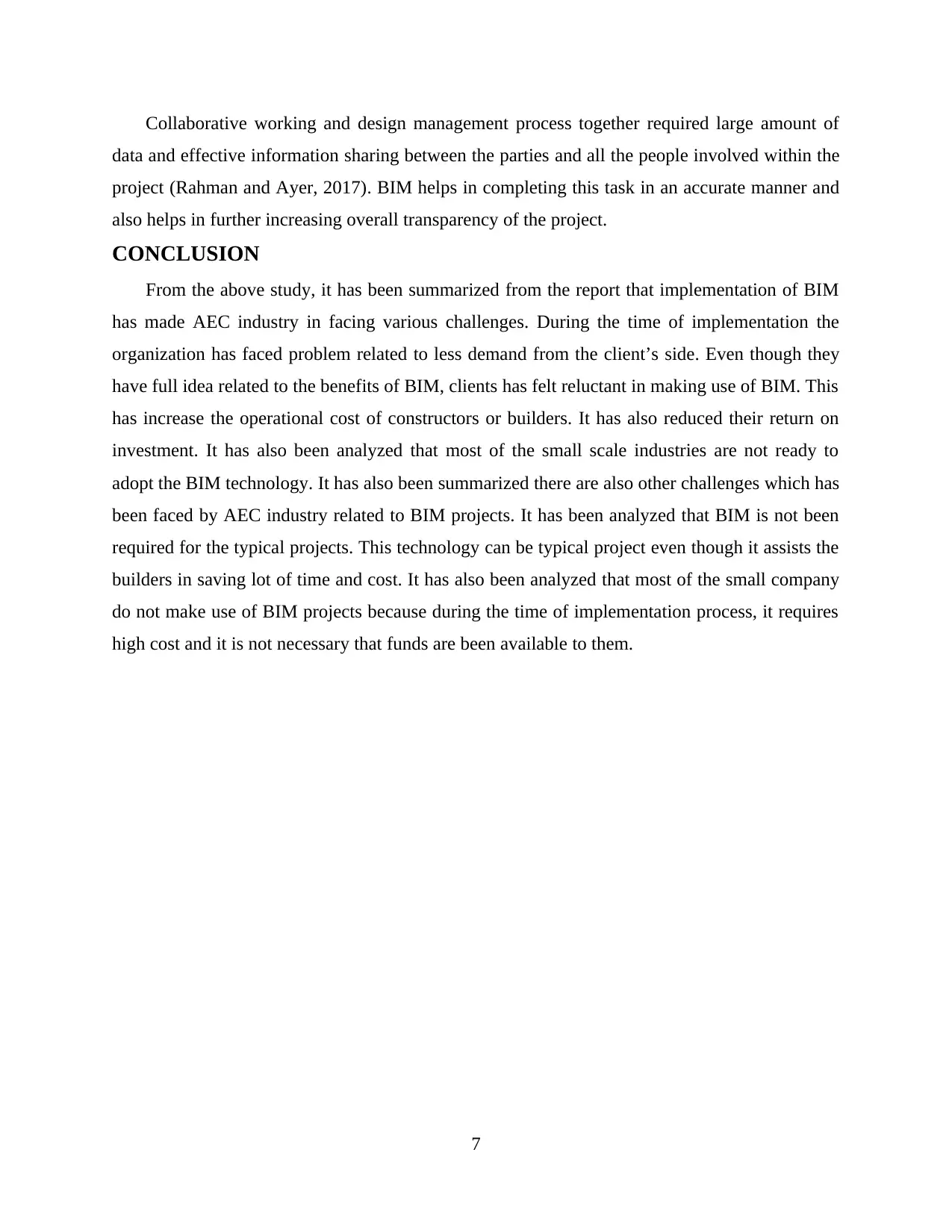
Collaborative working and design management process together required large amount of
data and effective information sharing between the parties and all the people involved within the
project (Rahman and Ayer, 2017). BIM helps in completing this task in an accurate manner and
also helps in further increasing overall transparency of the project.
CONCLUSION
From the above study, it has been summarized from the report that implementation of BIM
has made AEC industry in facing various challenges. During the time of implementation the
organization has faced problem related to less demand from the client’s side. Even though they
have full idea related to the benefits of BIM, clients has felt reluctant in making use of BIM. This
has increase the operational cost of constructors or builders. It has also reduced their return on
investment. It has also been analyzed that most of the small scale industries are not ready to
adopt the BIM technology. It has also been summarized there are also other challenges which has
been faced by AEC industry related to BIM projects. It has been analyzed that BIM is not been
required for the typical projects. This technology can be typical project even though it assists the
builders in saving lot of time and cost. It has also been analyzed that most of the small company
do not make use of BIM projects because during the time of implementation process, it requires
high cost and it is not necessary that funds are been available to them.
7
data and effective information sharing between the parties and all the people involved within the
project (Rahman and Ayer, 2017). BIM helps in completing this task in an accurate manner and
also helps in further increasing overall transparency of the project.
CONCLUSION
From the above study, it has been summarized from the report that implementation of BIM
has made AEC industry in facing various challenges. During the time of implementation the
organization has faced problem related to less demand from the client’s side. Even though they
have full idea related to the benefits of BIM, clients has felt reluctant in making use of BIM. This
has increase the operational cost of constructors or builders. It has also reduced their return on
investment. It has also been analyzed that most of the small scale industries are not ready to
adopt the BIM technology. It has also been summarized there are also other challenges which has
been faced by AEC industry related to BIM projects. It has been analyzed that BIM is not been
required for the typical projects. This technology can be typical project even though it assists the
builders in saving lot of time and cost. It has also been analyzed that most of the small company
do not make use of BIM projects because during the time of implementation process, it requires
high cost and it is not necessary that funds are been available to them.
7
⊘ This is a preview!⊘
Do you want full access?
Subscribe today to unlock all pages.

Trusted by 1+ million students worldwide
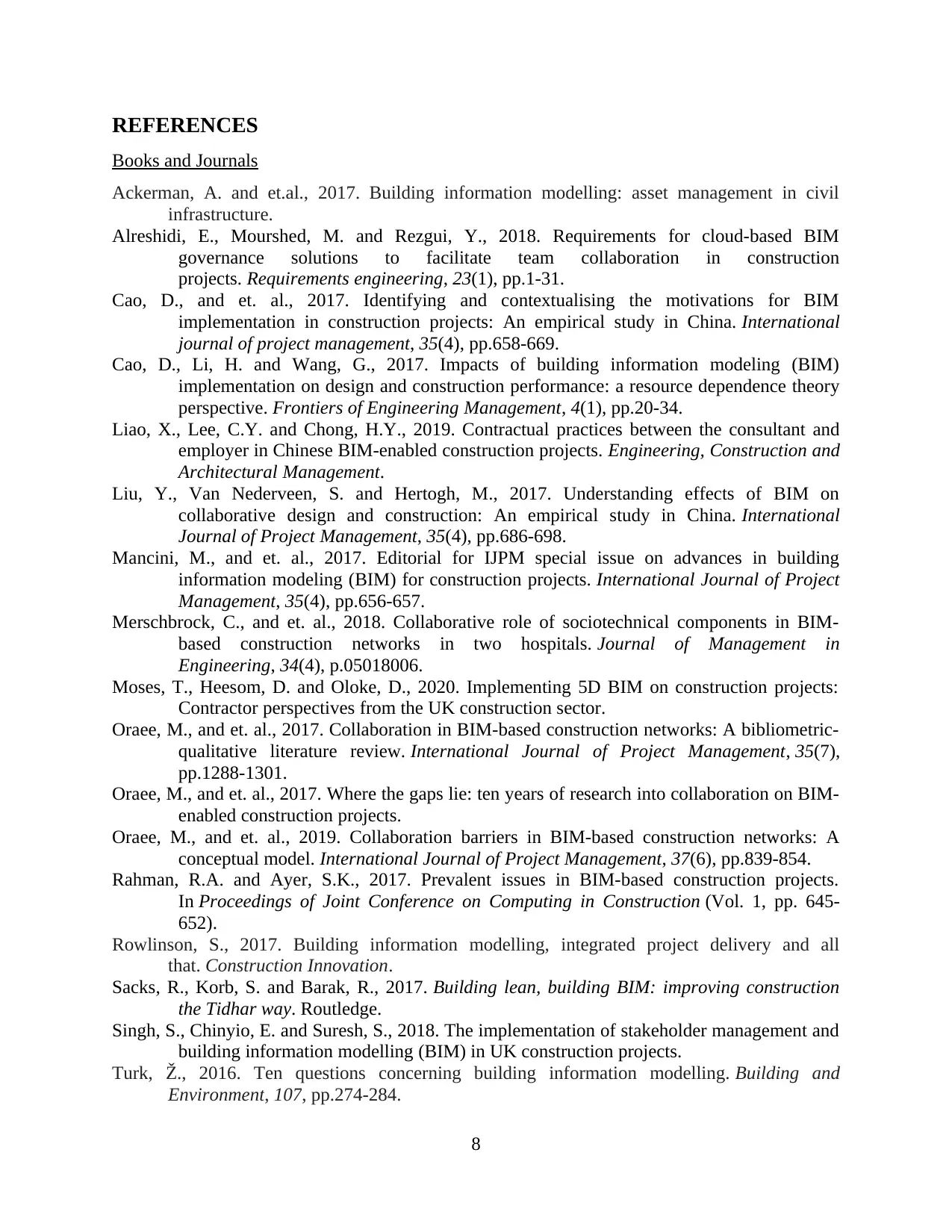
REFERENCES
Books and Journals
Ackerman, A. and et.al., 2017. Building information modelling: asset management in civil
infrastructure.
Alreshidi, E., Mourshed, M. and Rezgui, Y., 2018. Requirements for cloud-based BIM
governance solutions to facilitate team collaboration in construction
projects. Requirements engineering, 23(1), pp.1-31.
Cao, D., and et. al., 2017. Identifying and contextualising the motivations for BIM
implementation in construction projects: An empirical study in China. International
journal of project management, 35(4), pp.658-669.
Cao, D., Li, H. and Wang, G., 2017. Impacts of building information modeling (BIM)
implementation on design and construction performance: a resource dependence theory
perspective. Frontiers of Engineering Management, 4(1), pp.20-34.
Liao, X., Lee, C.Y. and Chong, H.Y., 2019. Contractual practices between the consultant and
employer in Chinese BIM-enabled construction projects. Engineering, Construction and
Architectural Management.
Liu, Y., Van Nederveen, S. and Hertogh, M., 2017. Understanding effects of BIM on
collaborative design and construction: An empirical study in China. International
Journal of Project Management, 35(4), pp.686-698.
Mancini, M., and et. al., 2017. Editorial for IJPM special issue on advances in building
information modeling (BIM) for construction projects. International Journal of Project
Management, 35(4), pp.656-657.
Merschbrock, C., and et. al., 2018. Collaborative role of sociotechnical components in BIM-
based construction networks in two hospitals. Journal of Management in
Engineering, 34(4), p.05018006.
Moses, T., Heesom, D. and Oloke, D., 2020. Implementing 5D BIM on construction projects:
Contractor perspectives from the UK construction sector.
Oraee, M., and et. al., 2017. Collaboration in BIM-based construction networks: A bibliometric-
qualitative literature review. International Journal of Project Management, 35(7),
pp.1288-1301.
Oraee, M., and et. al., 2017. Where the gaps lie: ten years of research into collaboration on BIM-
enabled construction projects.
Oraee, M., and et. al., 2019. Collaboration barriers in BIM-based construction networks: A
conceptual model. International Journal of Project Management, 37(6), pp.839-854.
Rahman, R.A. and Ayer, S.K., 2017. Prevalent issues in BIM-based construction projects.
In Proceedings of Joint Conference on Computing in Construction (Vol. 1, pp. 645-
652).
Rowlinson, S., 2017. Building information modelling, integrated project delivery and all
that. Construction Innovation.
Sacks, R., Korb, S. and Barak, R., 2017. Building lean, building BIM: improving construction
the Tidhar way. Routledge.
Singh, S., Chinyio, E. and Suresh, S., 2018. The implementation of stakeholder management and
building information modelling (BIM) in UK construction projects.
Turk, Ž., 2016. Ten questions concerning building information modelling. Building and
Environment, 107, pp.274-284.
8
Books and Journals
Ackerman, A. and et.al., 2017. Building information modelling: asset management in civil
infrastructure.
Alreshidi, E., Mourshed, M. and Rezgui, Y., 2018. Requirements for cloud-based BIM
governance solutions to facilitate team collaboration in construction
projects. Requirements engineering, 23(1), pp.1-31.
Cao, D., and et. al., 2017. Identifying and contextualising the motivations for BIM
implementation in construction projects: An empirical study in China. International
journal of project management, 35(4), pp.658-669.
Cao, D., Li, H. and Wang, G., 2017. Impacts of building information modeling (BIM)
implementation on design and construction performance: a resource dependence theory
perspective. Frontiers of Engineering Management, 4(1), pp.20-34.
Liao, X., Lee, C.Y. and Chong, H.Y., 2019. Contractual practices between the consultant and
employer in Chinese BIM-enabled construction projects. Engineering, Construction and
Architectural Management.
Liu, Y., Van Nederveen, S. and Hertogh, M., 2017. Understanding effects of BIM on
collaborative design and construction: An empirical study in China. International
Journal of Project Management, 35(4), pp.686-698.
Mancini, M., and et. al., 2017. Editorial for IJPM special issue on advances in building
information modeling (BIM) for construction projects. International Journal of Project
Management, 35(4), pp.656-657.
Merschbrock, C., and et. al., 2018. Collaborative role of sociotechnical components in BIM-
based construction networks in two hospitals. Journal of Management in
Engineering, 34(4), p.05018006.
Moses, T., Heesom, D. and Oloke, D., 2020. Implementing 5D BIM on construction projects:
Contractor perspectives from the UK construction sector.
Oraee, M., and et. al., 2017. Collaboration in BIM-based construction networks: A bibliometric-
qualitative literature review. International Journal of Project Management, 35(7),
pp.1288-1301.
Oraee, M., and et. al., 2017. Where the gaps lie: ten years of research into collaboration on BIM-
enabled construction projects.
Oraee, M., and et. al., 2019. Collaboration barriers in BIM-based construction networks: A
conceptual model. International Journal of Project Management, 37(6), pp.839-854.
Rahman, R.A. and Ayer, S.K., 2017. Prevalent issues in BIM-based construction projects.
In Proceedings of Joint Conference on Computing in Construction (Vol. 1, pp. 645-
652).
Rowlinson, S., 2017. Building information modelling, integrated project delivery and all
that. Construction Innovation.
Sacks, R., Korb, S. and Barak, R., 2017. Building lean, building BIM: improving construction
the Tidhar way. Routledge.
Singh, S., Chinyio, E. and Suresh, S., 2018. The implementation of stakeholder management and
building information modelling (BIM) in UK construction projects.
Turk, Ž., 2016. Ten questions concerning building information modelling. Building and
Environment, 107, pp.274-284.
8
Paraphrase This Document
Need a fresh take? Get an instant paraphrase of this document with our AI Paraphraser

Vilas-Boas, J. and et.al., 2019, September. Outlining a New Collaborative Business Model as a
Result of the Green Building Information Modelling Impact in the AEC Supply Chain.
In Working Conference on Virtual Enterprises (pp. 405-417). Springer, Cham.
Wang, Y., Gosling, J. and Naim, M.M., 2019. Assessing supplier capabilities to exploit building
information modelling. Construction Innovation.
Whitlock, K., and et. al., 2018. BIM for construction site logistics management. Journal of
Engineering, Project, and Production Management, 8(1), p.47.
9
Result of the Green Building Information Modelling Impact in the AEC Supply Chain.
In Working Conference on Virtual Enterprises (pp. 405-417). Springer, Cham.
Wang, Y., Gosling, J. and Naim, M.M., 2019. Assessing supplier capabilities to exploit building
information modelling. Construction Innovation.
Whitlock, K., and et. al., 2018. BIM for construction site logistics management. Journal of
Engineering, Project, and Production Management, 8(1), p.47.
9
1 out of 11
Related Documents
Your All-in-One AI-Powered Toolkit for Academic Success.
+13062052269
info@desklib.com
Available 24*7 on WhatsApp / Email
![[object Object]](/_next/static/media/star-bottom.7253800d.svg)
Unlock your academic potential
Copyright © 2020–2025 A2Z Services. All Rights Reserved. Developed and managed by ZUCOL.





